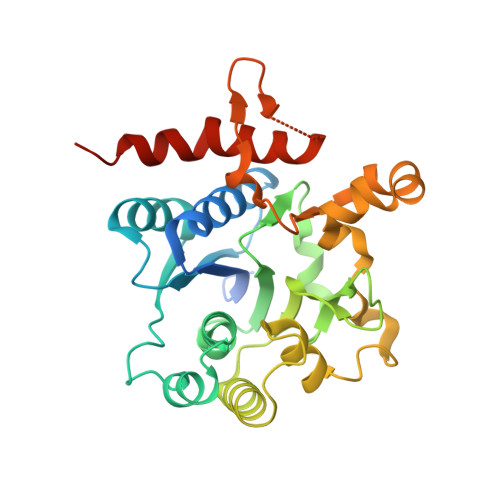Mechanisms of monomeric and dimeric glycogenin autoglucosylation.
Issoglio, F.M., Carrizo, M.E., Romero, J.M., Curtino, J.A.(2012) J Biol Chem 287: 1955-1961
- PubMed: 22128147
- DOI: https://doi.org/10.1074/jbc.M111.287813
- Primary Citation of Related Structures:
3USQ, 3USR - PubMed Abstract:
Initiation of glucose polymerization by glycogenin autoglucosylation at Tyr-194 is required to prime de novo biosynthesis of glycogen. It has been proposed that the synthesis of the primer proceeds by intersubunit glucosylation of dimeric glycogenin, even though it has not been demonstrated that this mechanism is responsible for the described polymerization extent of 12 glucoses produced by the dimer. We reported previously the intramonomer glucosylation capability of glycogenin without determining the extent of autoglucopolymerization. Here, we show that the maximum specific autoglucosylation extent (MSAE) produced by the non-glucosylated glycogenin monomer is 13.3 ± 1.9 glucose units, similar to the 12.5 ± 1.4 glucose units measured for the dimer. The mechanism and capacity of the dimeric enzyme to carry out full glucopolymerization were also evaluated by construction of heterodimers able to glucosylate exclusively by intrasubunit or intersubunit reaction mechanisms. The MSAE of non-glucosylated glycogenin produced by dimer intrasubunit glucosylation was 16% of that produced by the monomer. However, partially glucosylated glycogenin was able to almost complete its autoglucosylation by the dimer intrasubunit mechanism. The MSAE produced by heterodimer intersubunit glucosylation was 60% of that produced by the wild-type dimer. We conclude that both intrasubunit and intersubunit reaction mechanisms are necessary for the dimeric enzyme to acquire maximum autoglucosylation. The full glucopolymerization capacity of monomeric glycogenin indicates that the enzyme is able to synthesize the glycogen primer without the need for prior dimerization.
Organizational Affiliation:
Centro de Investigaciones en Química Biológica de Córdoba (CIQUIBIC, Universidad Nacional de Córdoba-Consejo Nacional de Investigaciones Científicas y Técnicas (UNC-CONICET)), Departamento de Química Biológica, Facultad de Ciencias Químicas, Universidad Nacional de Córdoba, X5000HUA Córdoba, Argentina.
















